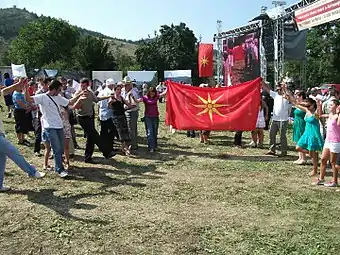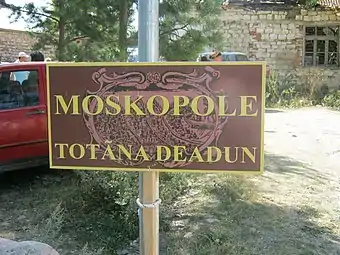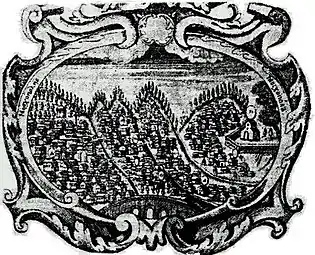 Map of Aromanian settlements in Albania.
(Red: Aromanians are the exclusive population in the settlement. Yellow: Aromanians form a majority or a substantial minority in the settlement) | |
| Total population | |
| 8,266 (2011 census) Estimates go from 30,000[1] to 200,000[2][3] | |
| Regions with significant populations | |
| Southern Albania Korçë County, Fier County, Gjirokastër County, Vlorë County, Berat County Central Albania Elbasan County, Durrës County, Tirana County | |
| Languages | |
| Aromanian (native), Albanian (Tosk dialect) | |
| Religion | |
| Predominantly Eastern Orthodoxy | |
| Related ethnic groups | |
| Aromanians |
The Aromanians in Albania (Aromanian: Rrãmãnji/Armãnji tu Arbinishii; Albanian: Arumunët/Vllehët në Shqipëri) are an officially recognised ethnic minority in Albania.[4]
Ethnonyms
| Part of a series on |
| Aromanians |
|---|
 |
The Aromanians in Albania are officially called the Minoriteti Arumun. The local population often refers to them as Vllehë, Çobenjë (from Turkish çoban, "shepherd"), Xacët or Xinxarët, Gogët, and Llacifacët.
History
The Aromanians were first recognized at the London Conference of 1912–13 as a minority group within Albania. They fought the Ottoman Empire alongside the Serbians and Greeks during the Balkan Wars.
During the communist regime in Albania, the Aromanians were not recognised as a separate minority group. Following the fall of communism in Albania, there was a revival of ethnic Aromanian identity in the country. Assimilation and identification have been and continue to be a complex issue relating to the Aromanians of Albania and the wider Balkans.[5]
Historical settlements
Moscopole

The city of Moscopole (Albanian: Voskopojë) was once home to the largest Aromanian population in the world. It was the cultural and commercial centre of the Aromanians with a population of over 3,500 people. The city was razed to the ground by Ali Pasha of Ioannina in 1788, causing an exodus of Aromanian people across the Balkans. Many of them ended up in what would become North Macedonia, Albania and Greece. The largest concentration of Aromanians was in the Pelister region of North Macedonia, the city of Kruševo and around the Lake Prespa. The Moscopolitans (Moscopoleanji in Aromanian), is one of the largest population of Aromanians today. They speak the Grabovean/Moscopolean dialect of Aromanian and are the descendants of the Graboveans/Moscopoleans in Krusevo (Aromanian: Crushuva, Macedonian: Крушево) are today a fully recognized minority group under the constitutional law of North Macedonia.
Grabova

Grabova was a medieval town created in the 10th century. Aromanians have left Grabova on several occasions, although the village has never been completely deserted. The first wave of depopulation took place in the 17th century, when Grabova shared the fate of Moscopole and during the inter-war period, starting with 1931, many of Grabovars emigrated to Elbasan and Lushnjë. In 1933, 15 families from the village emigrated to Romania; they initially settled in Southern Dobruja and then, in 1940, in the village of Nisipari, Constanța County, from where they moved to the larger nearby towns (Medgidia, Ovidiu, Constanța ) Another important immigration began in 1950, when communist authorities used the craftsmen from Grabova to build the industrial units in Korçë, Pogradec, Gramsh, Elbasan, and Tirana. The people of Grabova speak the Grabovean/Moscopolean dialect of Aromanian.
Culture
Music
Religion

Aromanians in Albania are predominantly Orthodox Christians like the rest of Aromanians. In Korçë (Aromanian: Curceauã, Curciau) they have an Aromanian-language church named Ayiu Sutir (Transfiguration of Jesus), and is the only church in Albania that is preaching in Aromanian language. Before that, they had another church also in Korçë with the same name, built in 1925 and destroyed by an earthquake in 1931.
Media
Aromanian-language media include the newspapers Popullorë and Ta Néa tis Omónias, both being pro-Greek. There are also the newspapers Frația Vëllazëria and Fratsilia which appear only irregularly.[6]
Education
As of 2001 there was no official education in Aromanian.[6]
Demographics
The exact presence of the Aromanian community in Albania is unknown. 8,266 people declared themselves to be Aromanians in the 2011 census.[7] On the quality of the specific data the Advisory Committee on the Framework Convention for the Protection of National Minorities stated that "the results of the census should be viewed with the utmost caution and calls on the authorities not to rely exclusively on the data on nationality collected during the census in determining its policy on the protection of national minorities.".[8] According to Tom Winnifrith in 1995, that there were about 200,000 individuals who were of Aromanian descent in Albania, regardless of proficiency in Aromanian, or spoke Aromanian without necessarily considering themselves to have a separate identity.[9][10] According to Frank Kressing and Karl Kaser in 2002, there were between 30,000 and 50,000 Aromanians in Albania.[1] In 2004 Arno Tanner pointed out Albania as the only country where Vlachs make a relatively significant percentage of population, around 2%.[9]
In the context of the census conducted in 2011 in Albania, representatives of the Aromanian community in the country stated that the results do not reflect the real number of the Aromanian population of Albania.[11]
List of settlements
In Albania, Aromanian communities inhabit Moscopole, their most famous settlement, the Kolonjë District (where they are concentrated), a quarter of Fier (Aromanian Ferãcã), while Aromanian was taught, as recorded by Tom Winnifrith, at primary schools in Andon Poçi near Gjirokastër, Shkallë (Aromanian Scarã) near Sarandë, and Borovë near Korçë (Aromanian Curceau) (1987).[12] A Romanian research team concluded in the 1960s that Albanian Aromanians migrated to Tirana, Stan Karbunarë, Skrapar, Pojan, Bilisht and Korçë, and that they inhabited Karaja, Lushnjë, Moscopole, Drenovë and Boboshticë (Aromanian Bubushtitsa).[12]


Central Albania
The Myzeqe (Aromanian: Muzachia) is an area in southwestern-central Albania which encompasses parts of the county of Fier (Aromanian: Ferãcã) . It has a large Aromanian population spread across many villages. The Aromanian inhabitants of Myzeqe are referred to as Muzachiars or Muzachirenji in Aromanian.
- Grabovë e Sipërme (Aromanian: Greãva, Grabuva)
Southern Albania
Berat County
Vlorë County
Gjirokastër Country
Korcë County
A large portion of Aromanians can be found in Southeastern Albania.
Minority status
The Aromanians were first recognized at the London Conference of 1912–1913 as a minority group until the communist era (1967). From 1967 until 1992, they were known as simple Albanians, and from 1992 until 2017, they were known as a cultural and linguistic minority. Since 2017, the Aromanians are an officially recognized ethnic minority in Albania.
The existing political divisions among the Aromanian population in Albania are the pro-Greek and Aromanian-only factions, which are the most numerous groups, as well as the pro-Romanian faction, the latter being less numerous. All of them promote their Aromanian ethnic background but differ on how they define their national identity. Namely, the pro-Greek group would concur with the majority of Aromanians in Greece that they are nationally Greek with Aromanian linguistic and cultural traits. On the other hand those supporting a completely distinct Aromanian identity claim that they are both nationally and ethnically Aromanians and would deny having Greek or Romanian national consciousness.[11]
The Aromanians have their own political party in Albania. It is known as the Alliance for Equality and European Justice (ABDE), it was founded in 2011[13] and aims for the unification of all the Albanian Aromanians.[14] There are only two other Aromanian political parties in the world, the Democratic Union of the Vlachs of Macedonia (DSVM) and the Party of the Vlachs of Macedonia (PVM), both in North Macedonia.
Education
.JPG.webp)
In the University of Tirana, the Aromanian language is covered by the Faculty of Foreign Languages.
Media
Aromanian-language media in Albania are RTSH 2 and RTSH Gjirokastra. RTSH 2 broadcasts from Monday to Friday news and programms in Aromanian Language, while RTSH Gjirokastra only once a week. Beside TV media are also the internet radio RTV Armakedon, newspaper Fratia, magazine Fãrshãrotu and Arumunët/Vllehtë
Notable people from Albania
Education:
- Daniel Moscopolites (1754–1825) - Aromanian scholar from modern-day Albania
- Aurel Plasari - Albanian intellectual[15]
- Ilo Mitkë Qafëzezi - Albanian intellectual
- Mitrush Kuteli - Albanian writer, literary critic and translator
Finance:
- Mocioni Family - Austro-Hungarian banking and philanthropist family.
Arts/Music:
- Albert Vërria (1936-2015) - Albanian actor[16]
- Sandër Prosi (1924-1985) - Albanian actor[17]
- Nikolla Zoraqi (1928–1991) - composer[17]
- Violeta Manushi (1926-2007) - actress
- Margarita Xhepa (1932-) - actress[17]
- Ndricim Xhepa (Aromanian mother) (1957-) - actor
- Eli Fara (1968-) - Singer and songwriter[18]
- Janaq Paço (1914-1991) - Albanian sculptor[19]
- Jakov Xoxa (1923-1979) - Albanian author and writer[20]
- Parashqevi Simaku (1966-) - Albanian former musician.[21]
Politics:
- Dhimitër Tutulani (19 March 1857 – 1937), Albanian lawyer and politician [22]
- Rita Marko (1920-2018) - Chairman of the Albanian Politburo.[23]
- Liri Gero (1926-1944) - Albanian World War II martyr and heroine.[20]
- Teodor Heba (1914-2001) - Albanian chairman of the Politburo from 1950 to 1951.[24]
- Nako Spiru (1918-1947) - Albanian communist politician[25]
- Llazar Fundo (1899-1944) - Albanian communist, former member of the Balkan communist federation, purged in 1944.
- Athanas Shundi (1892-1940) - Albanian politician, pharmacist, and early supporter of the Albanian Orthodox Church
Religion:
- Damian of Albania (1886-1973) - Archbishop of the Albanian Orthodox Church from 1966 to 1967
- Nektarios Terpos (end 17th–18th century) priest and author
- Theodore Kavalliotis (1718–1789) - Greek priest and teacher
- Ioakeim Martianos (1875-1955) - Greek priest & teacher.
Sports:
- Theoharis Trasha (1985-) - weightlifter
- Gert Trasha (1988-) - weightlifter
Other:
- Margarita Tutulani (1925 – 6 July 1943) anti-fascist
Gallery
 National Aromanian festival in Moscopole, 15 August 2010
National Aromanian festival in Moscopole, 15 August 2010 Sign in Aromanian language in Moscopole
Sign in Aromanian language in Moscopole Moscopole at 1742
Moscopole at 1742
See also
References
- 1 2 Kressing, Frank; Kaser, Karl (2002). Albania--a Country in Transition: Aspects of Changing Identities in a South-East European Country. Nomos. p. 12.
between 5,000 and 15,000 Macedonians and Montenegrins in the north and east ; between 30,000 and 50,000 Vlahs or Aromanians
- ↑ Schwandner-Sievers, Stephanie. "The Albanian Aromanians´ Awakening: Identity Politics and Conflicts in Post-Communist Albania" (PDF). European Centre for Minority Issues. p. 2. Archived from the original (PDF) on 3 January 2014. Retrieved 13 November 2012.
- ↑ Arno Tanner. The forgotten minorities of Eastern Europe: the history and today of selected ethnic groups in five countries. East-West Books, 2004 ISBN 978-952-91-6808-8, p. 218: "In Albania, Vlachs are estimated to number as many as 200,000"
- ↑ Project, Joshua. "Aromanian in Albania". Retrieved 29 August 2017.
- ↑ Schwandner-Sievers, Stephanie. "The Albanian Aromanians' Awakening: Identity Politics and Conflicts in Post-Communist Albania" (PDF). European Centre for Minority Issues (ECMI). pp. 3–7. Retrieved 17 March 2023.
In Albanian communist times they were not recognised as a separate minority group, officially considered to be almost completely assimilated and hence absorbed into the population statistics."..."In the early post-communist transition period a vivid Aromanian ethnic movement emerged in Albania. The slumber of a „sleeping beauty nation" ended and it became part of a recent global Balkan Aromanian initiative.
- 1 2 Kahl, Thede (2002). "The ethnicity of Aromanians after 1990: the identity of a minority that behaves like a majority". Ethnologia Balkanica. 6: 157.
- ↑ Population and Housing Census (Main Results) – 2011 (PDF) (Report). Institute of Statistics (Albania). 2012. p. 71. Retrieved 24 August 2021.
- ↑ "Third Opinion on Albania adopted on 23 November 2011". Advisory Committee on the Framework for the Protection of National Minorities. Retrieved 29 June 2017.
- 1 2 Tanner 2004, p. 209.
- ↑ Schwandner-Sievers, Stephanie (March 1999). "The Albanian Aromanians' Awakening: Identity Politics and Conflicts in Post-Communist Albania". www.ecmi.de. European Centre for Minority Issues. pp. 1–2. Archived from the original on 26 January 2020. Retrieved 17 August 2021.
Winnifrith increased these figures after repeated travels through Southern Albania. In his most recent estimate of 200,000 he includes all those who think of themselves as Vlachs / Aromanians in terms of descent with or without knowledge of the language as well as those who speak the language but do not refer to a distinct identity.
- 1 2 Stjepanovic, Dejan (2013). "Perceived Co-Ethnicss and Kin-State Citizenship in Southeastern Europe". SSRN Electronic Journal: 17. doi:10.2139/ssrn.2388698. ISSN 1556-5068. S2CID 141053504. Retrieved 28 September 2022.
- 1 2 Winnifrith 1987, p. 35.
- ↑ Mustaka, Valentin (2012). "Një vjetori i partisë "Aleanca për Barazi dhe Drejtësi Europiane" ABDE / Un an di la fundatsia a partidul "Ligãturea ti Egaliteati sh-Drept European" ABDE". Arumunët Albania (in Albanian and Aromanian). No. 19. pp. 2–5.
- ↑ "A.B.D.E Aleanca për barazi dhe drejtesi europiane me program politik, në thelb: Bashkimi i vllehëve në një forcë të vetme politke". City News Albania (in Albanian). 10 November 2016.
- ↑ Naegele, Jolyon (7 November 2001). "Albania: Vlach population, Aromanian language in danger of disappearing". Radio Free Europe/Radio Liberty.
- ↑ Bizhyti, Jovan (4 October 2015). "Vllehtë në hapësirat myzeqare". Archived from the original on 20 April 2020. Retrieved 4 September 2021.
- 1 2 3 Gusho, Jani (February 2011). "Fratia – VËLLAZËRIA" (in Romanian). p. 7.
...cu origina armână: Sandër Prosi, Prokop Mima și Margarita Xhepa, și compozitorlu mari Nikolla Zoraqi.
- ↑ Minga, Mikaela (2012). Këngë Korçare: Song Making and Musical Culture in the City of Korçë during the Twentieth Century (PDF) (Thesis). p. 266.
Eli Fara (b. 1967) is a singer of Aromanian descent.
- ↑ Government, Albanian (n.d.). "Armënët ose Vllehët e Shqipërisë". Albanian Government. Archived from the original on 20 June 2017.
- 1 2 Bizhyti, Jovan (4 October 2015). "Vllehtë në hapësirat myzeqare". Archived from the original on 5 October 2015.
- ↑ ""Cdo shekull Vëllezër"! – Dielli | The Sun". Retrieved 25 December 2021.
- ↑ "Minoriteti Vllah/Arumun | MINORITETET NË SHQIPËRI". Archived from the original on 20 June 2017. Retrieved 13 December 2021.
- ↑ Channel, TV1 (11 July 2018). "Dorëshkrimet e rralla të Rita Markos për luftën: Si e njoha Qemalin dhe Enverin". Archived from the original on 13 July 2018.
{{cite web}}: CS1 maint: numeric names: authors list (link) - ↑ "Arumunet albania nr 42". issuu. Retrieved 9 October 2021.
- ↑ "The Aromanian Question: Lessons of a Bloody History - Aromanian Cultural Society Farsharotu". 25 April 2018. Retrieved 4 January 2022.
Works cited
- Kahl, Thede (2002). "The ethnicity of Aromanians after 1990: the identity of a minority that behaves like a majority". Ethnologia Balkanica. 6: 145–169.
- Tanner, Arno (2004). The Forgotten Minorities of Eastern Europe. Helsinki: East West Books. ISBN 978-952-91-6808-8.
- Winnifrith, Tom (1987). The Vlachs: The History of a Balkan People (PDF). New York: Duckworth. ISBN 978-0-7156-2135-6.
- Kodra, Klara; Meta, Beqir (2014). "Shënime rreth çështjes vllahe: Çështja vllahe dhe konferenca e Londrës". Studime Historike. 1–2.
- Djordjević, Ljubica; Zaimi, Zenajda (2019). "Commentary: The Law on Protection of National Minorities in the Republic of Albania" (PDF). Journal on Ethnopolitics and Minority Issues in Europe. 18 (1).
External links
- "State Committee of Minorities" (in Albanian). Archived from the original on 29 December 2021. Retrieved 10 May 2019.
